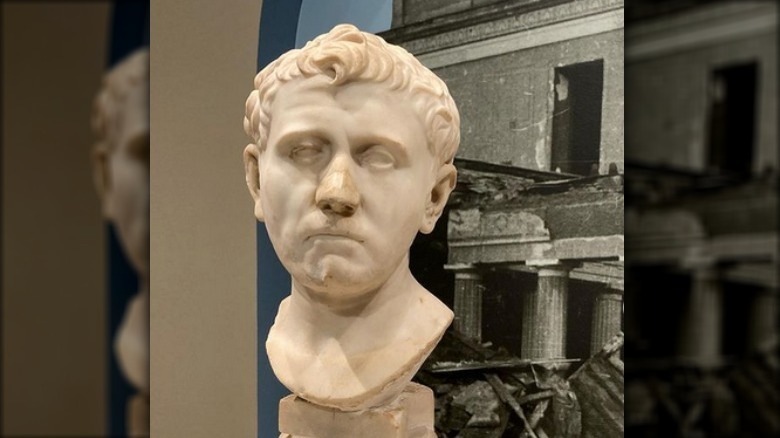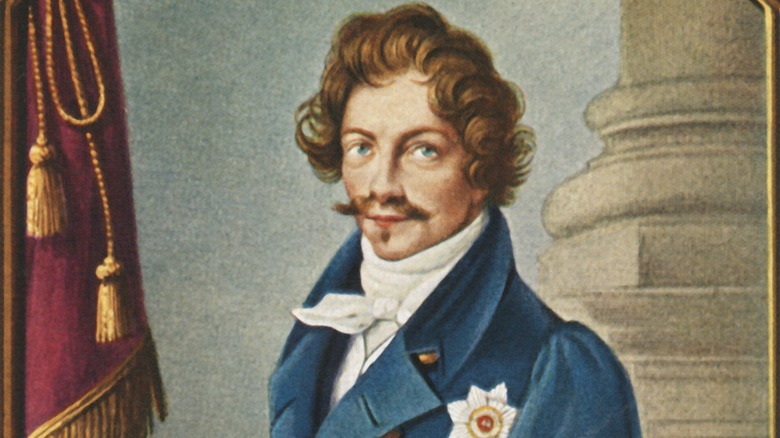The Mystery Of A Priceless Ancient Roman Bust That Ended Up At Goodwill
The fun thing about shopping at Goodwill is that you never know what might be hiding on a shelf — or in this case, under a table. If you're lucky, you'll find something that you need for a fraction of the cost you'd pay at a retail store. That's if you're lucky: if you're really lucky, however, you could find an ancient relic that is priceless.
That's exactly what happened when vintage store owner Laura Young went shopping at a Goodwill in Austin, Texas, in 2018. Young looks for rare art to resell, and one day she spotted a bust that looked like an antique on the floor under a table. She told The Art Newspaper that it looked "pretty dirty, pretty old," and thought that someone might like to clean it up and use it in their garden. Young was intrigued with the piece, which is made of white marble and weighs 52 pounds, and she wanted to know more about it. Through some digging, she found out that she could have something valuable on her hands.
The bust is from the first century
Young consulted with experts at the University of Texas at Austin and at auction houses across the U.S. to get more information about the bust. Experts told her that the relic dates to the first century A.D.
There is no way to be certain who the sculpture depicts, but Jessica Powers, interim chief curator of the art of the ancient Mediterranean world at the museum, told The Art Newspaper that it might be a son of Pompey the Great, who was a Roman general who married Julius Caesar's daughter. Certain details, such as curled locks of hair and a furrowed brow, match other details of the leader.
Others, however, think it could be a detail of ancient Roman commander Drusus Germanicus. The Art Newspaper reports that Drusus was a Roman commander who helped Rome conquer German land. KUT reports that through her research, Young found out that a bust of Drusus was identified as an item found in a German Museum.
King Ludwig I had the bust for awhile
It was Jörg Deterling, a consultant from Sotheby's auction house, who traced the bust to Germany. More specifically, to Aschaffenburg, where it sat in a full-scale model of a Pompeii villa, called a Pompejanum, built by King Ludwig I of Bavaria (via San Antonio Museum of Art). Ludwig was a lover of art, and made plans for all kinds of buildings to fill the streets of Munich, including churches and monuments, per Simply Munich. He had several museums built, and he is credited with opening the first museum in Europe. According to Bayerische Schlösserverwaltung, the Pompejanum was completed between 1840 and 1848.
Ludwig was also an art collector, and he was especially interested in work from the Italian Renaissance. Simply Munich explains that in 1830, he acquired several exhibits from Greece and Rome, and The Art Newspaper theorizes that it is possible that the sculpture of Drusus was in one of these collections (though that cannot be confirmed). Now, the only question remaining was how it ended up at a Goodwill in Austin.
The bust is believed to have been stolen
The San Antonio Museum of Art speculates that the bust stayed in the Pompejanum until World War II, when the Allies bombed Aschaffenburg, seriously damaging the building. The U.S. Army established several military stations in the area after the war, and it is believed at some point that an American soldier stole the item, bringing it home with him to Texas. Of course, there is no way to know where in Texas it ended up, or how it found its way to the Goodwill in Austin.
While it might seem unusual to find such relics in the world today, Stephennie Mulder, art history professor at University of Texas at Austin, told KUT that it is well known that many of the artifacts in the Pompejanum were looted. She also said that while there are plenty of them scattered around the world, finding one in a Goodwill is "extraordinary."
It's illegal to sell stolen artifacts
Young finally had the answers she was looking for, but now she had a new dilemma — what to do with the artifact. Selling it was illegal, which she found out when she contacted museums to find out if they were interested in it. She couldn't keep it, either, so she found an attorney who specializes in antique law to help her figure out what to do next. Negotiations were complicated and slow, but Young told KUT that she enjoyed having the relic in her home. She even named it Dennis — after the character Dennis Reynolds played by Glenn Howerton in the television series "It's Always Sunny in Philadelphia."
Young finally reached a confidential deal with the Germans in late 2021 after the Bavarian Administration of State-Owned Palaces, Gardens, and Lakes authenticated the bust, reports Forbes. The center also agreed to pay for costs that covered storage, insurance, shipping, and Young's finder's fee (via The Art Newspaper).
The bust is going back to Bavaria
Currently, the bust, titled "Portrait of a Man," is on display at the San Antonio Museum of Art (SAMA), where it will remain until the summer of 2023, according to The Art Newspaper. SAMA houses a collection of Roman art, and the facility played a part in returning the piece to Bavaria. After that, the artifact will make its way back to the Bavarian Administration of State-Owned Palaces, Gardens and Lakes Museum in Germany, which is known as one of the largest museums in the country (via Bayerische Schlösserverwaltung).
Young said letting the sculpture go was "bittersweet." She also said that the relic needed to go back home, adding that it was not supposed to end up in the U.S. Before she let it go, however, she had a 3-D copy of it printed, which sits among a collection of other busts in her home.





